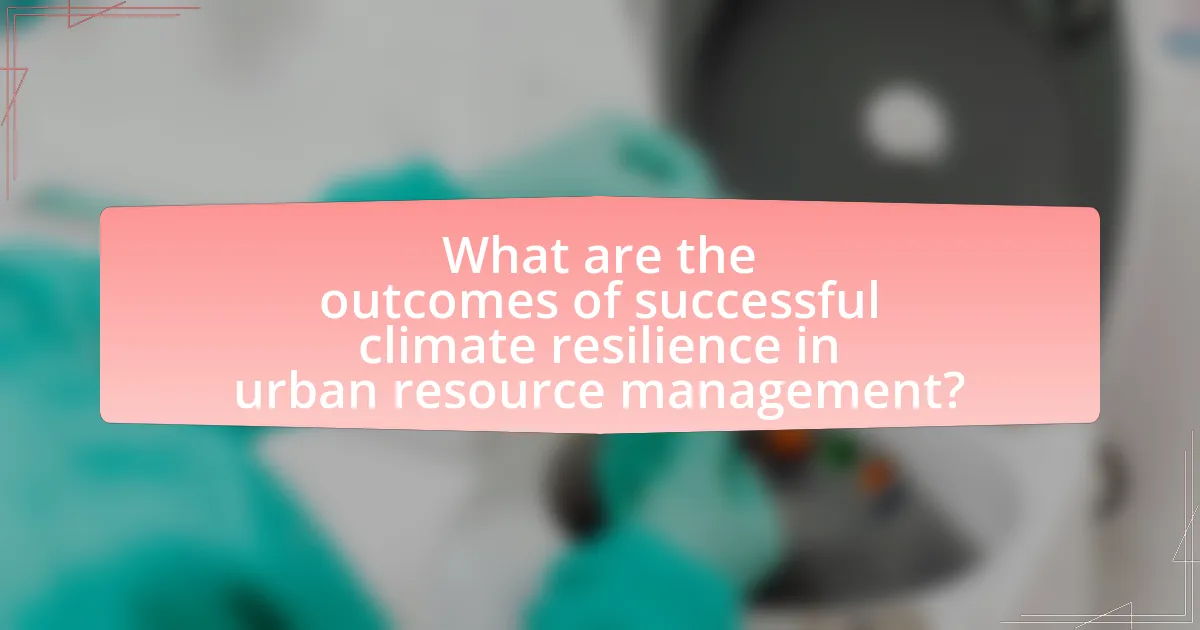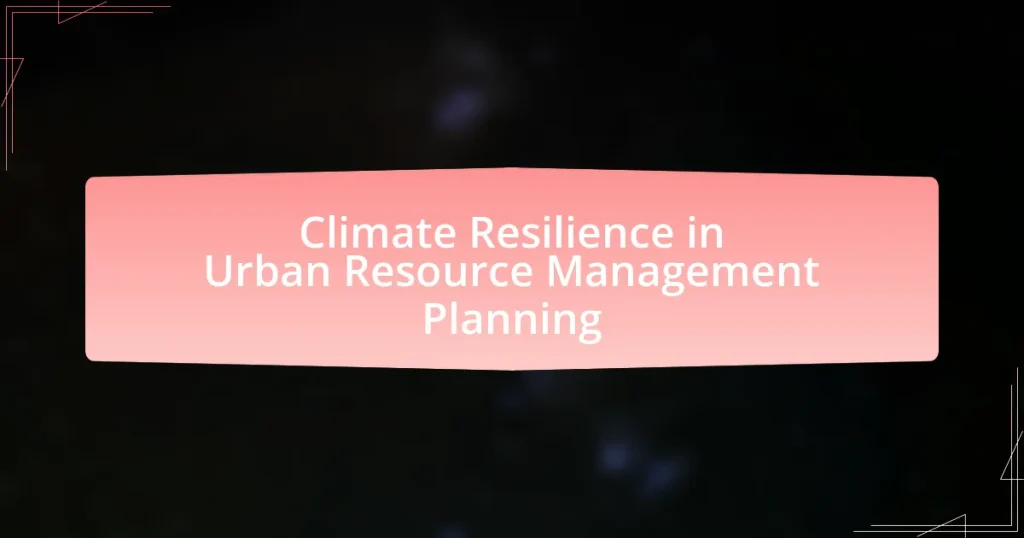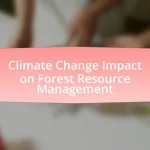Climate resilience in urban resource management planning refers to the ability of urban systems to effectively anticipate, prepare for, respond to, and recover from climate-related hazards while maintaining essential functions. The article outlines the significance of integrating climate risk assessments into urban planning, emphasizing strategies such as green infrastructure, community engagement, and adaptive management to enhance sustainability and reduce vulnerability to climate impacts. It also discusses the differences between climate resilience and traditional resource management, the importance of stakeholder involvement, and the role of technology in supporting resilience initiatives. Furthermore, the article highlights the challenges cities face in implementing these strategies, including financial barriers and the need for improved policy frameworks, while showcasing successful case studies that inform future urban planning efforts.

What is Climate Resilience in Urban Resource Management Planning?
Climate resilience in urban resource management planning refers to the capacity of urban systems to anticipate, prepare for, respond to, and recover from climate-related hazards while maintaining essential functions. This concept emphasizes the integration of climate risk assessments into urban planning processes, ensuring that infrastructure, services, and resources are designed to withstand extreme weather events, such as floods, heatwaves, and storms. Evidence from cities implementing climate resilience strategies, such as New York’s post-Hurricane Sandy recovery efforts, demonstrates that proactive planning can significantly reduce vulnerability and enhance community resilience.
How does climate resilience impact urban resource management?
Climate resilience significantly enhances urban resource management by enabling cities to adapt to climate-related challenges, ensuring sustainable resource use. This adaptation involves integrating climate risk assessments into planning processes, which helps cities prioritize investments in infrastructure, water supply, and energy systems that can withstand extreme weather events. For instance, cities that have adopted climate resilience strategies, such as New York’s post-Hurricane Sandy initiatives, have improved their stormwater management systems, reducing flooding risks and optimizing water resource allocation. Such proactive measures not only safeguard urban resources but also promote long-term economic stability and environmental sustainability.
What are the key principles of climate resilience in urban planning?
The key principles of climate resilience in urban planning include adaptability, sustainability, and stakeholder engagement. Adaptability ensures that urban systems can adjust to changing climate conditions, such as increased flooding or heatwaves, by incorporating flexible designs and infrastructure. Sustainability focuses on minimizing environmental impact and promoting resource efficiency, which can be achieved through green building practices and renewable energy sources. Stakeholder engagement involves involving community members and local organizations in the planning process to ensure that diverse perspectives and needs are addressed, fostering a sense of ownership and responsibility towards climate resilience initiatives. These principles are supported by research indicating that cities implementing such strategies are better equipped to withstand climate-related challenges, as seen in case studies from cities like Rotterdam and New York.
How does climate resilience differ from traditional resource management?
Climate resilience focuses on adapting to and preparing for the impacts of climate change, while traditional resource management primarily emphasizes the sustainable use and conservation of resources without necessarily accounting for climate variability. Climate resilience incorporates strategies that enhance the ability of communities and ecosystems to withstand and recover from climate-related shocks, such as extreme weather events, whereas traditional resource management often relies on historical data and stable conditions to guide decision-making. For instance, climate resilience planning may involve the development of green infrastructure to manage stormwater, which directly addresses the increased flooding risks associated with climate change, contrasting with traditional methods that may simply aim to optimize existing drainage systems without considering future climate scenarios.
Why is climate resilience important for urban areas?
Climate resilience is crucial for urban areas because it enables cities to withstand and recover from climate-related shocks and stresses. Urban areas, which are often densely populated and economically vital, face increased risks from climate change, including flooding, heatwaves, and extreme weather events. For instance, according to the Intergovernmental Panel on Climate Change (IPCC), urban areas are projected to experience more intense and frequent climate impacts, making resilience planning essential for safeguarding infrastructure, public health, and economic stability. By investing in climate resilience, cities can enhance their adaptive capacity, reduce vulnerability, and ensure sustainable development in the face of ongoing environmental changes.
What are the potential risks of climate change on urban resources?
Climate change poses significant risks to urban resources, including water supply, energy systems, and infrastructure. Increased temperatures and altered precipitation patterns can lead to water scarcity, affecting drinking water availability and agricultural productivity. For instance, a study by the Intergovernmental Panel on Climate Change (IPCC) indicates that urban areas may experience a 20-30% reduction in freshwater availability by 2050 due to climate impacts. Additionally, extreme weather events, such as floods and heatwaves, can damage infrastructure, disrupt energy supply, and increase maintenance costs. The National Oceanic and Atmospheric Administration (NOAA) reports that the frequency of severe storms has increased, leading to higher repair costs for urban infrastructure. These risks necessitate proactive urban resource management strategies to enhance resilience against climate change.
How can climate resilience enhance urban sustainability?
Climate resilience enhances urban sustainability by enabling cities to adapt to climate change impacts while maintaining essential functions and services. This adaptability is crucial as urban areas face increasing threats from extreme weather events, rising sea levels, and resource scarcity. For instance, cities that invest in green infrastructure, such as parks and permeable surfaces, can manage stormwater more effectively, reducing flooding risks and improving water quality. Research shows that urban areas with robust climate resilience strategies can lower their vulnerability to climate-related disruptions by up to 50%, thereby ensuring long-term sustainability and livability.

What strategies are used to enhance climate resilience in urban resource management?
Strategies to enhance climate resilience in urban resource management include the implementation of green infrastructure, integrated water resource management, and community engagement initiatives. Green infrastructure, such as green roofs and permeable pavements, helps manage stormwater and reduce urban heat, thereby mitigating climate impacts. Integrated water resource management promotes the sustainable use of water resources, ensuring availability during droughts and resilience against flooding. Community engagement initiatives empower local populations to participate in decision-making processes, fostering adaptive capacity and local knowledge integration. These strategies are supported by evidence showing that cities employing such approaches experience reduced vulnerability to climate-related disruptions, as highlighted in studies by the Intergovernmental Panel on Climate Change.
How can cities implement effective climate resilience strategies?
Cities can implement effective climate resilience strategies by integrating adaptive infrastructure, enhancing community engagement, and utilizing data-driven decision-making. Adaptive infrastructure includes building flood defenses, improving drainage systems, and retrofitting buildings to withstand extreme weather events, which is essential as urban areas face increasing risks from climate change. Community engagement fosters local participation in resilience planning, ensuring that strategies reflect the needs and knowledge of residents, which has been shown to improve the effectiveness of such initiatives. Data-driven decision-making involves using climate models and risk assessments to inform urban planning, allowing cities to prioritize investments in resilience measures based on projected climate impacts. For example, the City of New York’s “OneNYC” plan incorporates these elements, aiming to reduce vulnerability to climate change while promoting sustainable growth.
What role does community engagement play in these strategies?
Community engagement is essential in climate resilience strategies for urban resource management planning as it fosters collaboration between stakeholders, enhances local knowledge, and builds trust. Engaging the community allows for the incorporation of diverse perspectives, ensuring that strategies are tailored to meet the specific needs and values of the population. Research indicates that community involvement leads to more effective implementation of climate adaptation measures, as seen in case studies where local input significantly improved project outcomes. For instance, the National Oceanic and Atmospheric Administration (NOAA) emphasizes that community-driven initiatives result in higher participation rates and better resource allocation, ultimately strengthening urban resilience against climate impacts.
How can technology support climate resilience initiatives?
Technology can support climate resilience initiatives by providing advanced data analytics, modeling tools, and real-time monitoring systems. These technologies enable cities to assess vulnerabilities, predict climate impacts, and develop adaptive strategies. For instance, Geographic Information Systems (GIS) allow urban planners to visualize and analyze spatial data related to climate risks, while predictive modeling can forecast extreme weather events, helping communities prepare effectively. Additionally, IoT sensors can monitor environmental conditions, providing critical data that informs decision-making and resource allocation. According to a report by the World Bank, integrating technology into urban planning can enhance resilience by up to 30%, demonstrating its effectiveness in mitigating climate-related risks.
What are the challenges in implementing climate resilience strategies?
The challenges in implementing climate resilience strategies include inadequate funding, lack of political will, and insufficient data. Inadequate funding limits the ability to develop and maintain necessary infrastructure, as seen in many cities where budget constraints hinder resilience projects. Lack of political will can stall initiatives, as decision-makers may prioritize short-term gains over long-term sustainability, evidenced by the slow progress in climate action in various regions. Insufficient data hampers effective planning and decision-making, as many urban areas lack comprehensive assessments of climate risks, which is critical for tailoring resilience strategies to specific local conditions.
What financial barriers do cities face in adopting these strategies?
Cities face significant financial barriers in adopting climate resilience strategies, primarily due to limited budgets and competing priorities. Many urban areas struggle with insufficient funding for infrastructure improvements, which are essential for implementing these strategies. For instance, a report by the National League of Cities highlights that nearly 70% of cities cite budget constraints as a major obstacle to investing in climate resilience initiatives. Additionally, cities often lack access to affordable financing options, making it difficult to secure the necessary capital for large-scale projects. This financial strain is compounded by the need for ongoing maintenance and operational costs associated with new systems designed to enhance resilience.
How can policy frameworks be improved to support climate resilience?
Policy frameworks can be improved to support climate resilience by integrating adaptive management practices that prioritize sustainability and community engagement. This approach ensures that policies are flexible and responsive to changing climate conditions, allowing for real-time adjustments based on scientific data and local needs. For instance, the National Oceanic and Atmospheric Administration (NOAA) emphasizes the importance of incorporating climate projections into urban planning to enhance resilience against extreme weather events. Additionally, policies should promote collaboration among stakeholders, including government agencies, local communities, and private sectors, to foster a holistic approach to resource management. Evidence from the Intergovernmental Panel on Climate Change (IPCC) indicates that inclusive decision-making processes lead to more effective climate adaptation strategies, ultimately strengthening urban resilience.

What are the outcomes of successful climate resilience in urban resource management?
Successful climate resilience in urban resource management leads to enhanced sustainability, improved public health, and increased economic stability. These outcomes are achieved through the integration of adaptive strategies that mitigate the impacts of climate change, such as flooding and heatwaves. For instance, cities that implement green infrastructure, like permeable pavements and urban forests, can reduce stormwater runoff by up to 65%, thereby decreasing flood risks and improving water quality. Additionally, resilient urban systems promote energy efficiency and reduce greenhouse gas emissions, contributing to better air quality and public health outcomes. Economic stability is bolstered as resilient cities attract investment and create jobs in green sectors, with studies indicating that every dollar invested in climate resilience can yield up to four dollars in economic returns.
How does climate resilience contribute to urban quality of life?
Climate resilience enhances urban quality of life by reducing vulnerability to climate-related hazards and ensuring sustainable resource management. Cities that implement climate resilience strategies, such as green infrastructure and improved drainage systems, experience fewer disruptions from extreme weather events, which directly impacts residents’ safety and well-being. For instance, a study by the Urban Land Institute found that cities with robust climate adaptation plans can reduce economic losses from flooding by up to 50%, thereby maintaining community stability and enhancing overall livability. Additionally, climate-resilient urban areas often promote better air quality and access to green spaces, contributing to improved physical and mental health for residents.
What are the measurable benefits of implementing climate resilience practices?
Implementing climate resilience practices yields measurable benefits such as reduced economic losses, improved public health, and enhanced ecosystem services. For instance, cities that invest in green infrastructure, like urban forests and permeable pavements, can decrease stormwater runoff by up to 30%, which mitigates flooding and reduces infrastructure repair costs. Additionally, studies show that climate-resilient urban planning can lead to a 10-20% reduction in heat-related illnesses, thereby improving public health outcomes. Furthermore, enhancing biodiversity through climate resilience practices can increase ecosystem services, such as pollination and carbon sequestration, which are valued at billions of dollars annually. These measurable benefits underscore the importance of integrating climate resilience into urban resource management planning.
How can successful case studies inform future urban planning?
Successful case studies can inform future urban planning by providing evidence-based strategies that enhance climate resilience. For instance, the implementation of green infrastructure in cities like New York has demonstrated significant reductions in urban heat and improved stormwater management, leading to a 30% decrease in flooding incidents during heavy rainfall. These documented outcomes serve as a blueprint for other urban areas facing similar climate challenges, allowing planners to adopt proven methods that mitigate risks associated with climate change. Additionally, case studies from cities such as Copenhagen, which has integrated extensive cycling infrastructure, show how sustainable transportation solutions can reduce carbon emissions by up to 40%, further guiding urban planners in developing eco-friendly policies.
What best practices can cities adopt for climate resilience?
Cities can adopt several best practices for climate resilience, including implementing green infrastructure, enhancing emergency preparedness, and promoting sustainable land use. Green infrastructure, such as green roofs and permeable pavements, helps manage stormwater and reduce urban heat, as evidenced by a study from the National Oceanic and Atmospheric Administration, which found that cities with green infrastructure can reduce flooding by up to 30%. Enhancing emergency preparedness involves developing comprehensive disaster response plans and conducting regular drills, which can significantly improve community resilience during climate-related events. Additionally, promoting sustainable land use through zoning regulations that prioritize mixed-use development and protect natural habitats can mitigate the impacts of climate change, as shown by research from the Urban Land Institute, indicating that well-planned urban areas are more resilient to climate stressors.
How can cities prioritize actions for maximum impact on resilience?
Cities can prioritize actions for maximum impact on resilience by conducting comprehensive risk assessments to identify vulnerabilities and critical infrastructure needs. This approach allows urban planners to allocate resources effectively, focusing on areas most susceptible to climate-related threats. For instance, cities like New York have implemented the Climate Resiliency Design Guidelines, which emphasize the importance of integrating climate risk into urban planning processes. By utilizing data-driven models and engaging community stakeholders, cities can ensure that their resilience strategies are both targeted and inclusive, ultimately enhancing their capacity to withstand and recover from climate impacts.
What role do partnerships play in enhancing urban climate resilience?
Partnerships play a crucial role in enhancing urban climate resilience by facilitating collaboration among various stakeholders, including government agencies, private sector entities, and community organizations. These collaborations enable the pooling of resources, knowledge, and expertise, which are essential for developing and implementing effective climate adaptation strategies. For instance, the Global Covenant of Mayors for Climate and Energy has demonstrated that cities that engage in partnerships can share best practices and innovative solutions, leading to more robust climate action plans. Additionally, research indicates that cities with strong multi-stakeholder partnerships are better equipped to respond to climate-related challenges, as they can leverage diverse perspectives and resources to address vulnerabilities effectively.
What practical steps can urban planners take to improve climate resilience?
Urban planners can improve climate resilience by implementing green infrastructure, such as green roofs, permeable pavements, and urban forests. These strategies enhance stormwater management, reduce urban heat, and improve air quality. For instance, a study by the National Oceanic and Atmospheric Administration (NOAA) found that green roofs can reduce surface temperatures by up to 40% during peak summer months, thereby mitigating heat island effects. Additionally, planners should prioritize mixed-use developments and transit-oriented designs to reduce reliance on cars, which contributes to greenhouse gas emissions. Research from the Urban Land Institute indicates that walkable neighborhoods can decrease vehicle miles traveled by 20-40%, further enhancing climate resilience. Finally, engaging communities in the planning process ensures that local knowledge and needs are incorporated, leading to more effective and sustainable solutions.


